Contents
Potato Mayak is a table variety of culture that has appeared on the market recently, but has already managed to gain popularity among experienced and novice gardeners. This is due to its ability to easily adapt to any climatic conditions, stable yields and unpretentiousness. Also, many gardeners note its multi-tuber nature and excellent taste. However, in order for the yield of the variety to be maximum, the basic requirements of this type of crop must be observed.
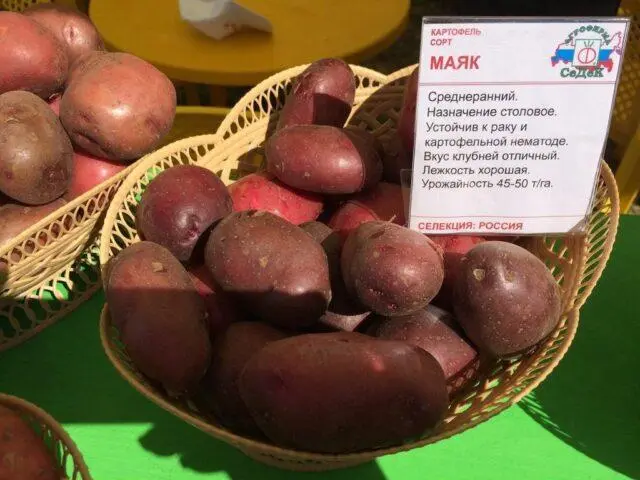
Variety Mayak is resistant to degeneration
The story of
The Mayak potato was bred thanks to the efforts of the employees of the Ural Research Institute of Agriculture. What kind of varieties became the basis for it is unknown. When it was created, the goal was to obtain a species with high resistance to temperature extremes and diseases, as well as a stable yield. And, judging by the declared characteristics of the variety, the creators succeeded.
Therefore, in 2009 an application was submitted for the Mayak potato to be entered into the State Register. Variety tests were carried out over the next four years. Based on their results, Mayak was officially registered in 2013.
Description of the Mayak potato variety with a photo
This potato has some differences in the appearance of bushes and tubers from other types of crops. Therefore, knowing them, it is possible to determine compliance with the variety without much difficulty.
Bush
Potato Mayak forms tall or medium bushes of an intermediate type. Stems are strong, thickened. Initially, they are upright growing, and later slightly deviate to the sides. In each bush, 4-5 shoots are formed per season. The leaves of the Lighthouse are of a standard shape, of medium size, of a dark green hue. The edges of the plates are slightly wavy. Basically, the shoots are densely leafy at the top, and their lower part is bare.
Lighthouse inflorescences are large. Light lilac buds. The inner part of the corollas has a pronounced anthocyanin color. Duration of flowering varieties 14-16 days.
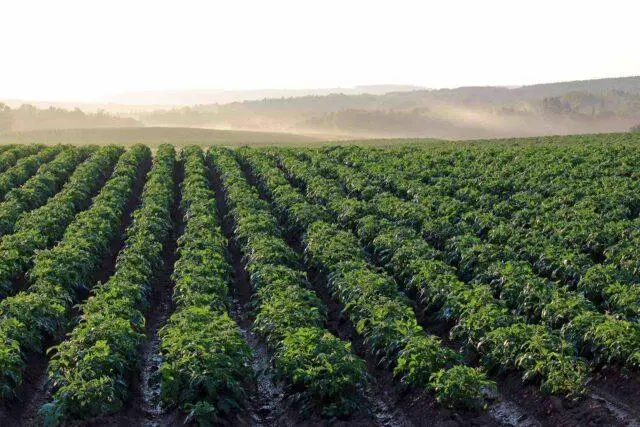
Berry formation at Mayak is rare
Tubers
Potato Lighthouse is characterized by a well-developed root system. During the season, from 12 to 18 aligned tubers are formed under each bush. Their weight varies between 97-153 g. The tubers of the Lighthouse are oval in shape with a rough surface. The peel is a uniform red hue. The eyes are superficial, small, inconspicuous.
The flesh of this potato is white, medium density. The starch content in it is 14,6-17,3%. When exposed to air, the flesh does not darken.
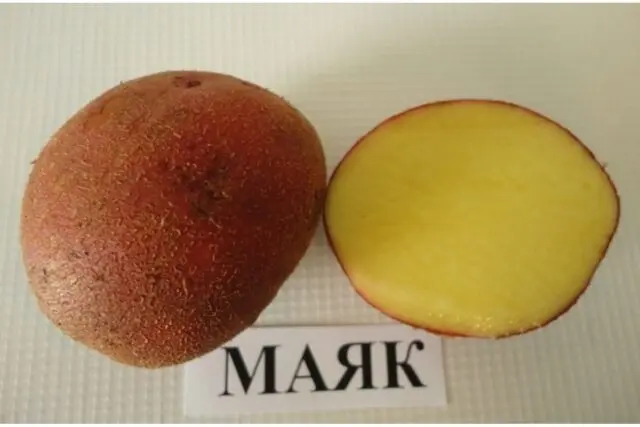
The yield of marketable fruits of the variety is 88-91%
Characteristics of potato Lighthouse
The productivity of Mayak potatoes can be determined by their characteristics. This will allow you to get a complete picture of the variety and compare it with other types of culture.
Taste qualities of Mayak potatoes
Taste qualities of the Lighthouse are good. In the process of cooking, the pulp practically does not boil soft and has an appetizing appearance.
The variety is suitable for:
- boils in a purified form and “uniform”;
- frying;
- roasting;
- stuffing;
- salads;
- first and second courses.
Terms of maturation
This variety is considered medium early. The duration of its growing season is 75-85 days. Therefore, when planting in mid-May, harvesting can be carried out already in the first decade of August. However, depending on the region of cultivation, the terms may be shifted by 7-10 days.
Productivity
Potato Mayak is characterized by a stable yield even in unfavorable seasons for the crop. As a result of the variety tests, it was found that the productivity of the variety is 117−393 c/ha.
Where is grown
Potato Mayak is recommended for cultivation on the territory of the Volga-Vyatka region. However, judging by the reviews of gardeners, it remains productive in the central regions of the country. The variety is not suitable for cultivation in the southern regions, as it is demanding on watering and does not tolerate dry air.
Disease resistance
This potato has resistance to potato cancer, golden nematode and wrinkled, banded mosaics. It also has relative immunity to common scab, rhizoctoniosis, and various rots. Mayak’s tops and tubers are moderately susceptible to late blight, so it is not recommended to delay harvesting.
Advantages and disadvantages
This variety of potatoes has many advantages, which is confirmed by the reviews of gardeners. However, it also has certain disadvantages that must be considered when choosing.
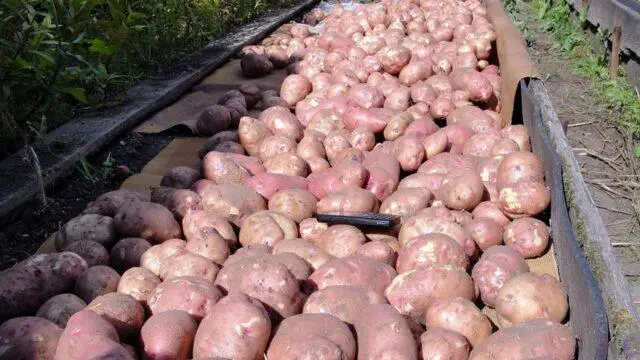
The lighthouse tolerates transportation well
The main advantages:
- stable yield;
- multituberity;
- the evenness of the fruit;
- excellent presentation;
- good taste;
- versatility of application;
- high level of keeping quality;
- fast adaptation to any climatic conditions;
- resistance to temperature extremes.
Disadvantages:
- susceptibility to late blight;
- not suitable for puree;
- watering requirements.
Planting Potatoes Lighthouse
For the successful cultivation of Mayak potatoes from seeds, you need to properly plant them. The rate of development of bushes and their productivity directly depend on this.
Three weeks before planting, seed potatoes are recommended to be brought into the room and scattered in one layer. During this time, you need to maintain the temperature at +15 ° C, regularly spray the tubers and turn.
For Mayak potatoes, it is necessary to choose a sunny open area, while it is important that it is well lit throughout the day. Two weeks before planting, you need to dig it up, add humus at the rate of 10 kg per 1 sq. m and carefully level the surface.
The soil should be loose, nutritious and have good moisture and air permeability. Mayak potatoes can fully develop in sandy, loamy soils and chernozems. It is important that the acidity level is neutral. It is also possible to plant this variety in clay soil. But first you need to add sand to it at the rate of 10 kg per 1 sq. m.
It is recommended to make holes for potatoes Lighthouse at a distance of 35 cm, and maintain a distance of 60 cm between rows. Planting depth in light, loose soil is 10 cm, and heavy soil
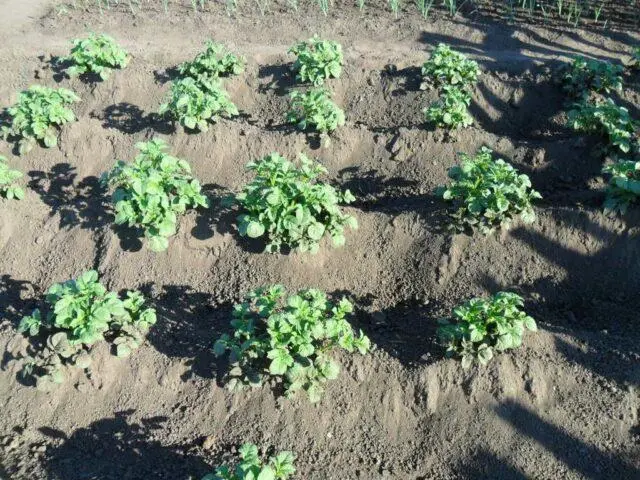
Potato Lighthouse undemanding to the composition of the soil
Care instructions
Caring for this variety of crop involves compliance with standard agricultural practices. Ten days after planting, it is recommended to loosen the soil to a depth of 1,5 cm. This will keep the air available to the tubers. In the future, loosening should be carried out after each watering or rain, until the bushes close. You also need to regularly weed, removing growing weeds at an early stage of potato development.
The lighthouse does not tolerate drought well. Therefore, in the absence of rain for a long time, it is necessary to irrigate with wetting the soil to a depth of 10 cm.
To increase the yield, Mayak potatoes need to be fed three times per season. The first time to apply fertilizer during the growth of shoots. At this time, it is recommended to use organic matter: chicken manure 1:15 and mullein 1:10. In their absence, it is possible to use ammonium nitrate at the rate of 30 g per 10 liters of water.
The second and third dressings are recommended before and after flowering. During these periods, superphosphate 30 g and potassium sulfide 25 g per 10 liters of water should be used. Starting from mid-June, it is not recommended to feed Mayak potatoes with nitrogen fertilizers, as they stimulate excessive growth of the aerial part to the detriment of the ovary of tubers.
The first time it is necessary to spud Mayak potato bushes at a shoot height of 15-18 cm, and again ten days after that. The recommended mound height is 2/3 of the total length of the shoots. The earth must be taken from the row spacing with the help of a plow, hiller, walk-behind tractor.
When to harvest and how to store
You can start harvesting Mayak potatoes when the shoots begin to turn yellow and dry out sharply. This feature indicates the maturation of tubers and their readiness for long-term storage. It is recommended to dig potatoes in the morning in dry weather. After that, the crop should remain in the garden for two hours. And only then it can be transferred to the room.
After four weeks, the harvested crop must be sorted out and sorted into large, seed and small tubers. It is also necessary to immediately discard damaged and cut specimens, as they will rot during storage. It is necessary to save Mayak potatoes in winter in the basement at a temperature of +4 ° C and air humidity of 70%.
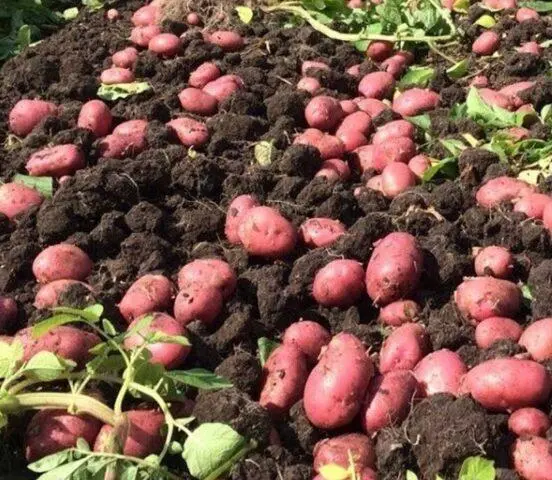
If all conditions are met, the crop is stored until the new season.
Conclusion
Potato Mayak is one of the new promising varieties that are suitable for growing in regions with difficult climatic conditions. It shows a stable yield, undemanding to growing conditions, and its cultivation does not cause difficulties. With standard care, this variety shows performance much higher than other types of crops.









